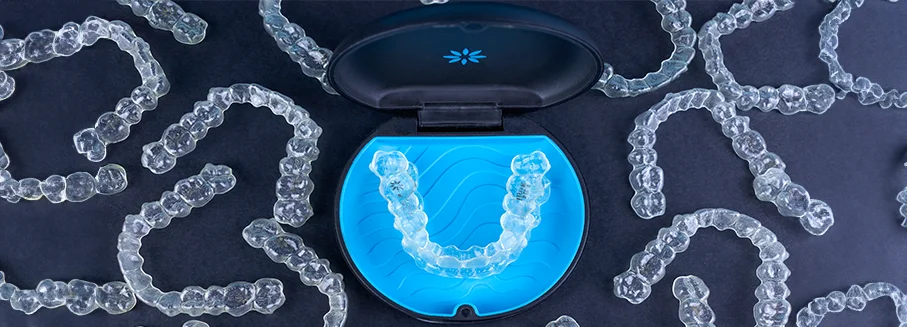- We Offer Instant Financing | Learn More
- Emergency Dental
- New Patients:
587-205-6093 - Current Patients:
403-527-9833 - Pay Now
Orthodontics and Functional Orthopedics at Medicine Hat
What is Orthopedics and why would you need it? If your jaw structure has formed with too little space for your teeth to grow in straight or your facial structure is such that you have difficulty breathing, you could be a candidate for Orthopedics. Orthopedics helps people at a young age to correct issues with their oral cavity. Problems can arise due to mouth breathing, tongue positioning, allergies or jaw position. With the use of orthopedic devices, your dentist can correct many of the problems associated with the shape of your oral cavity. Specific treatments will vary from patient to patient.
Functional Orthopedics helps certain muscles by using various removable appliances. These appliances help adjust your teeth into the correct position. A physical therapist may be recommended to help with certain techniques and therapies. Orthopedic therapy may include the use of ice, heat or electrical stimulation along with ultrasound techniques. This type of therapy is useful to move joints and muscles and reduce pain.
Request an AppointmentWho need orthodontic devices?
Do you or your children have crooked teeth and want to correct the alignment? You likely have considered braces. There are several orthodontic devices to help fix those misaligned teeth ranging from traditional metal braces to invisible braces. These devices are worn over a specific period to adjust the irregularities with your teeth. Your dentist will assess the complete structure of your oral cavity and recommend which device will best work for the results you desire. Before a recommendation is made, x-rays, pictures, and dental impressions will be required, and all this will be done during your appointment. You don’t have to live with crooked teeth since braces and retainers can give you the smile you have always wanted and guess what? When your teeth are straight, they are easier to clean so it is more likely you can avoid gum disease and decay if you keep your teeth clean.
How do braces work?
When you need to change the alignment of your teeth, braces are likely to be recommended by your dentist. These metal devices have various components including, brackets, wires, bands, and rings. The combination of these components helps gently put pressure on your teeth so they move into the correct position. Of course, this does not happen overnight. Braces work slowly and require adjusting to gently change the shape of your oral cavity and are worn for several months before you will see the results. After they are removed, you will likely have to wear a retainer for some time to maintain the positioning of your teeth. Teeth that are aligned correctly are easier to clean and offer more protection against some types of gum disease. What do you need to know about braces?

What are the parts of braces?
Brackets: These little squares are bonded to the front of each tooth and attached by archwires to help shift your teeth into place.
Orthodontic Bands: Bands are secured around each tooth as an anchor for the brackets.
Spacers: Small devices to help make space for the orthodontic bands.
Archwires: Wires are attached to the brackets to help gently move your teeth.
Ties: Small thin wires or rubber rings that fasten the archwire to the brackets.
Buccal Tube: Keeps the archwire in the correct location
Ligatures or Small Elastic Bands: Attached to the brackets
Springs: Springs in between the brackets are used to adjust the amount of space between your teeth.
Depending on your situation, your dentist may recommend using headgear in conjunction with your braces. To help move your upper molars backwards, a face-bow device can be used. When your teeth are extremely crowded with little room in your mouth, this device, in conjunction with your braces, can assist in correcting your bite.
Elastic or Rubber Bands: Your braces will have small hooks attached to them for attaching rubber bands. The rubber bands help apply gentle pressure to move your teeth into the correct position. This helps fine-tune the fit of your bite.
Braces do not come in a “one size fits all” device. Your dentist will determine what type of braces will work to best align your teeth. Regular sized and mini braces are available as well as invisible braces for less severe misaligned teeth.
Invisalign® invisible braces are a popular choice for many people. This type of braces can be worn without anyone even noticing you are wearing them. Not everyone is a good candidate for invisible braces, check with your dentist to see if this option will work for you. Generally, invisible braces work well for teeth with minimal overcrowding issues.
Why do I need a retainer?
You just got your braces off and are ecstatic about the look of your beautiful straight teeth so why do you need to wear a retainer? The braces you wore for months have done a great job but to maintain the alignment of your teeth you need a retainer. A retainer will help your teeth to stay in position after the braces have been removed. You may have to wear it for several months to prevent your teeth from shifting out of place. Retainers that are worn regularly help your teeth stay straight and your tongue be in the correct placement.
If you want to have straight teeth, braces are a sure way to achieve your goal. Your orthodontist at Park Meadows Dental will guide you through all the options available for your individual situation. We want you to show off your beautiful smile and we can make it happen.


